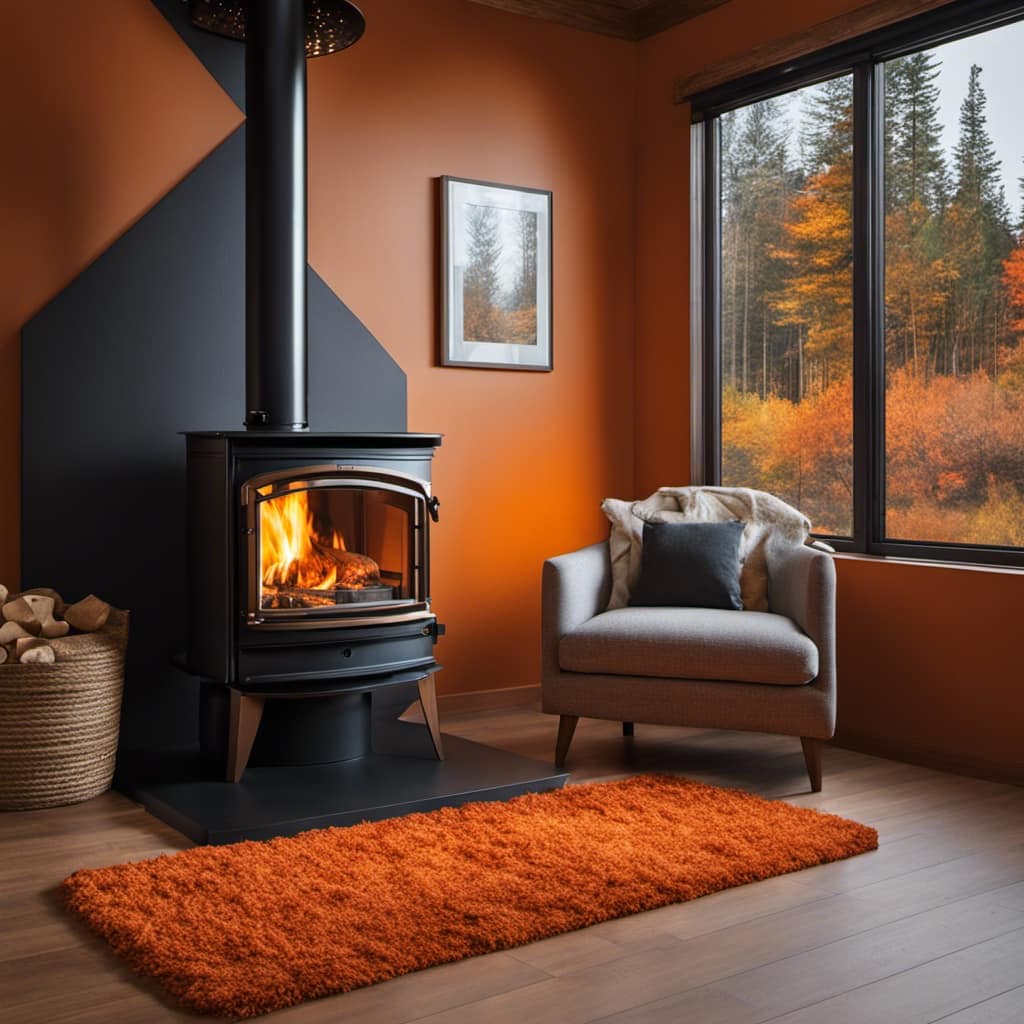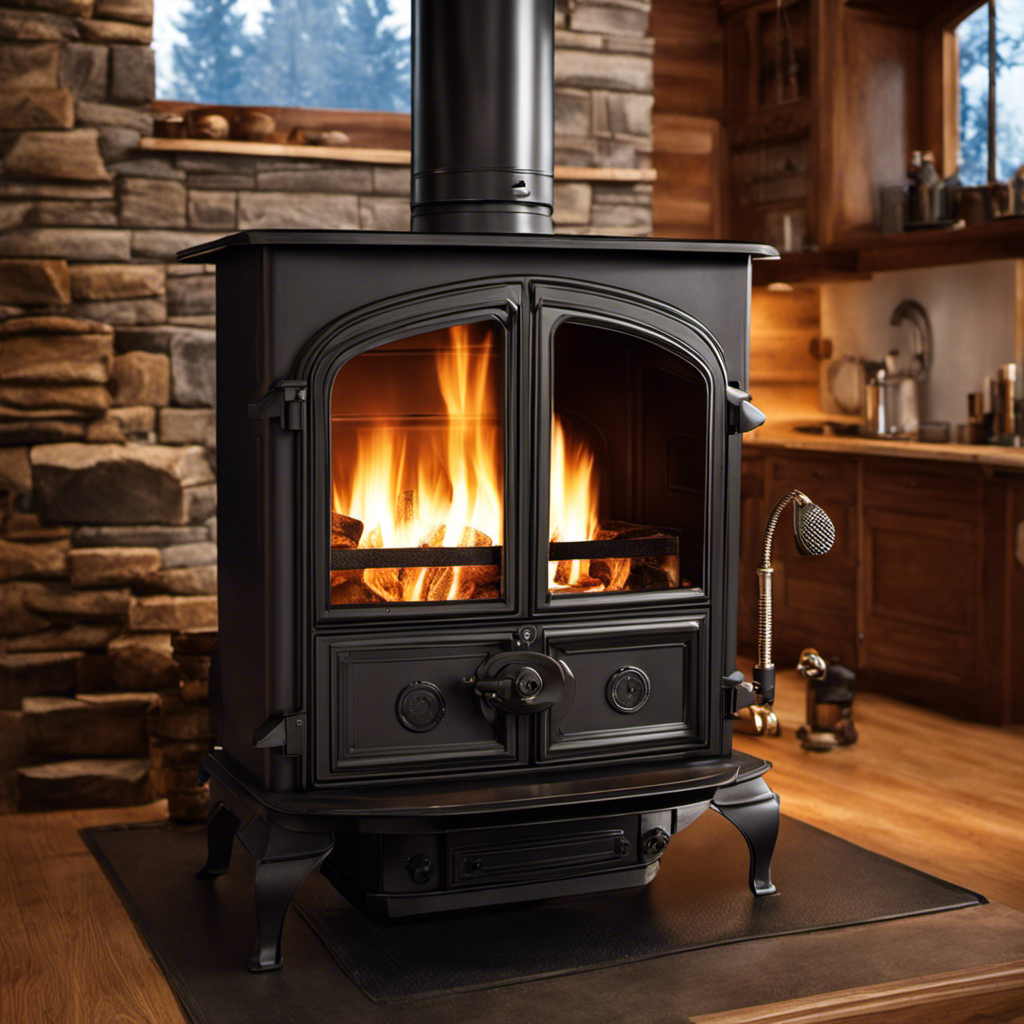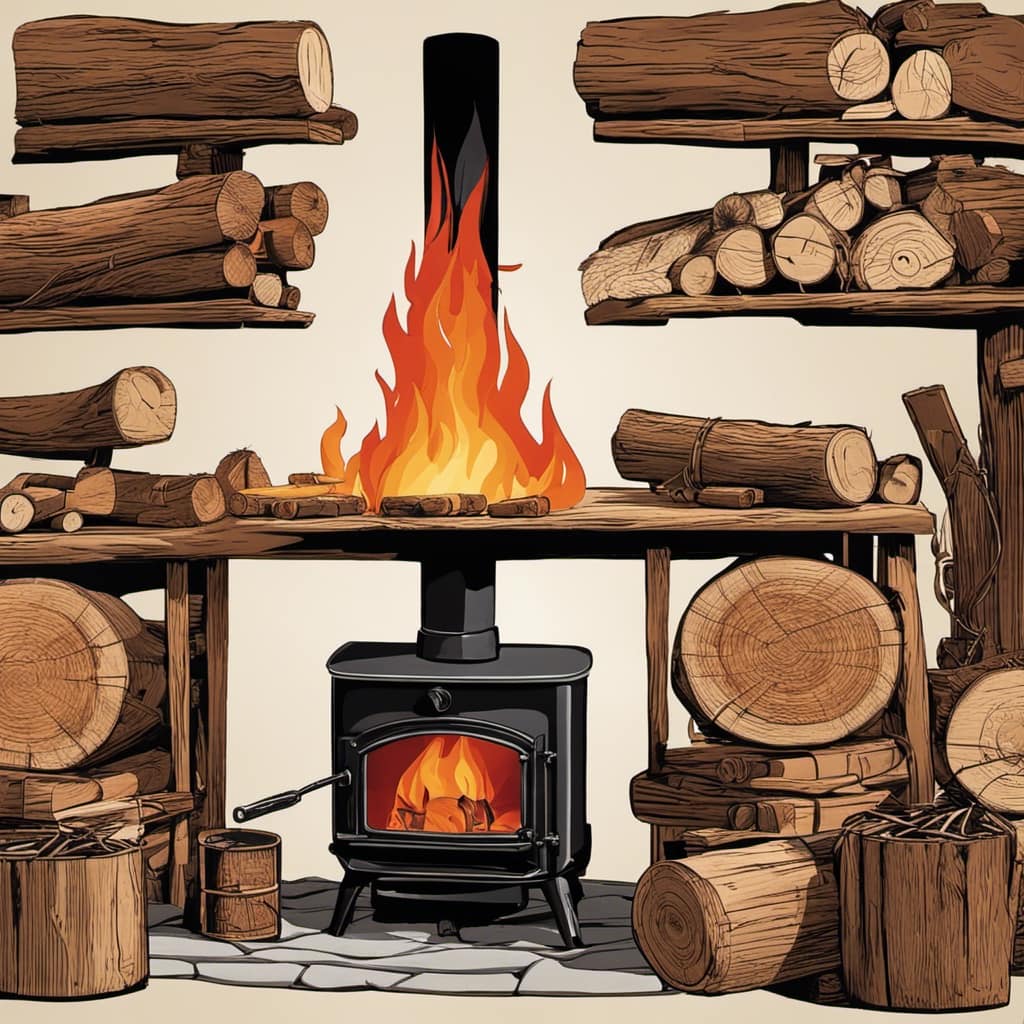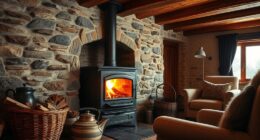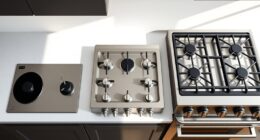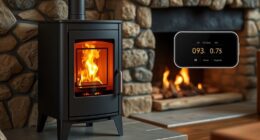I have always appreciated the comforting heat that my wood-burning stove provides. However, I am aware of a possible downside: the heat it emits may pose a risk of damaging nearby walls and furniture.
That’s when I learned about heat shields. These ingenious devices protect your home by redirecting heat away from combustible materials.
In this article, I’ll explain what a heat shield is, the benefits of using one, different types available, installation methods, and essential maintenance tips.
Stay safe and keep your wood stove roaring with a reliable heat shield.
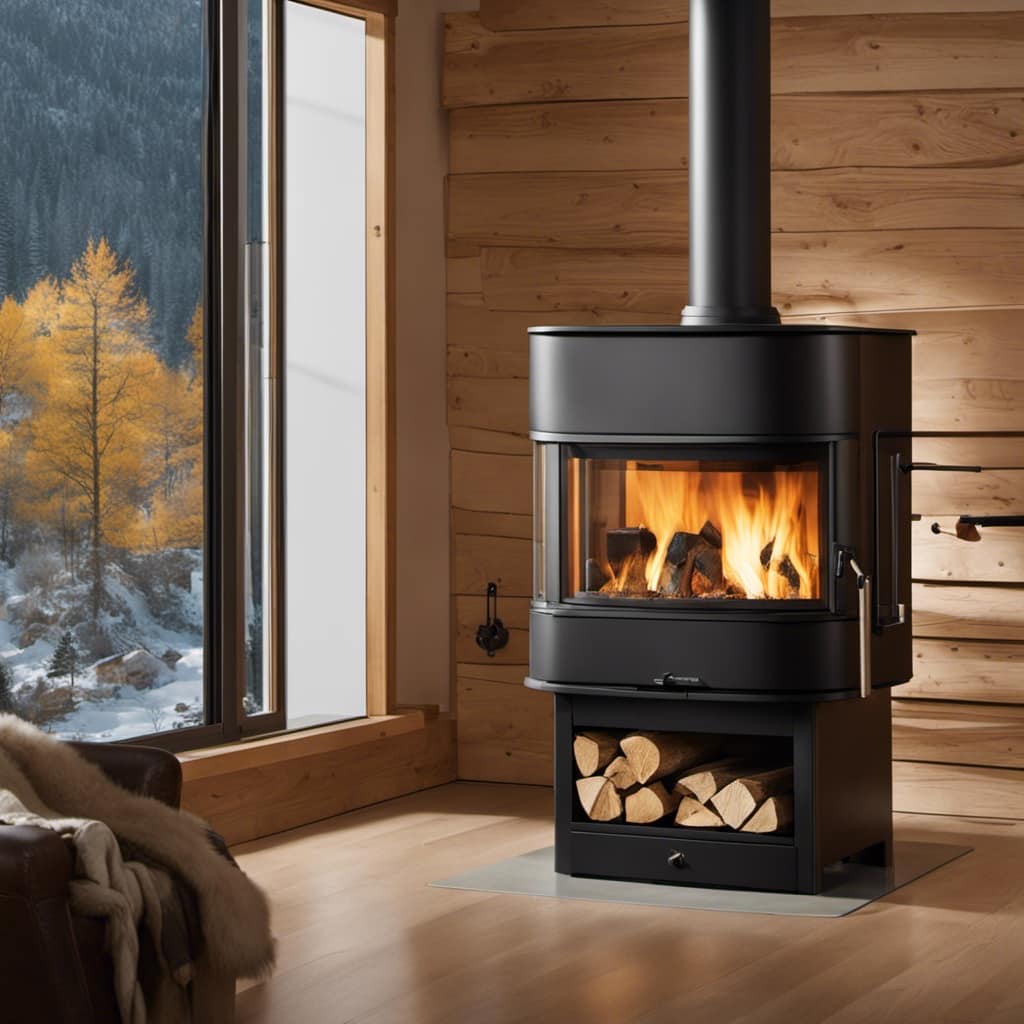
Key Takeaways
- A heat shield for a wood stove protects surrounding walls from excessive heat, acts as a barrier to prevent heat from reaching combustible materials, and reduces the risk of fire hazards.
- It allows the wood stove to be placed closer to the wall, saving space, and improves wood stove efficiency by reflecting heat back into the room.
- Different types of heat shields, such as sheet metal, ceramic tiles, specialized panels made of rock wool or fiberglass, and reflective barriers, can be used based on specific requirements.
- Proper installation methods, regular maintenance, and following safety precautions are essential for the effective and safe use of heat shields for wood stoves.
Purpose of a Heat Shield
I can clearly see that the purpose of a heat shield for a wood stove is to protect the surrounding walls from excessive heat. A heat shield acts as a barrier, preventing heat from reaching combustible materials and reducing the risk of fire hazards.
One of the advantages of using a heat shield is that it allows you to place your wood stove closer to the wall, saving valuable space in your home. Additionally, heat shields can improve the efficiency of your wood stove by reflecting heat back into the room, rather than letting it escape through the walls.
These shields are typically made from non-combustible materials such as sheet metal, ceramic tiles, or special heat-resistant boards. These materials are chosen for their ability to withstand high temperatures and provide an effective insulation layer between the stove and the walls.
Benefits of Using a Heat Shield
Using a heat shield can significantly increase the efficiency of my wood stove by directing the heat into the room instead of being absorbed by the walls. Here are three benefits of using a heat shield:
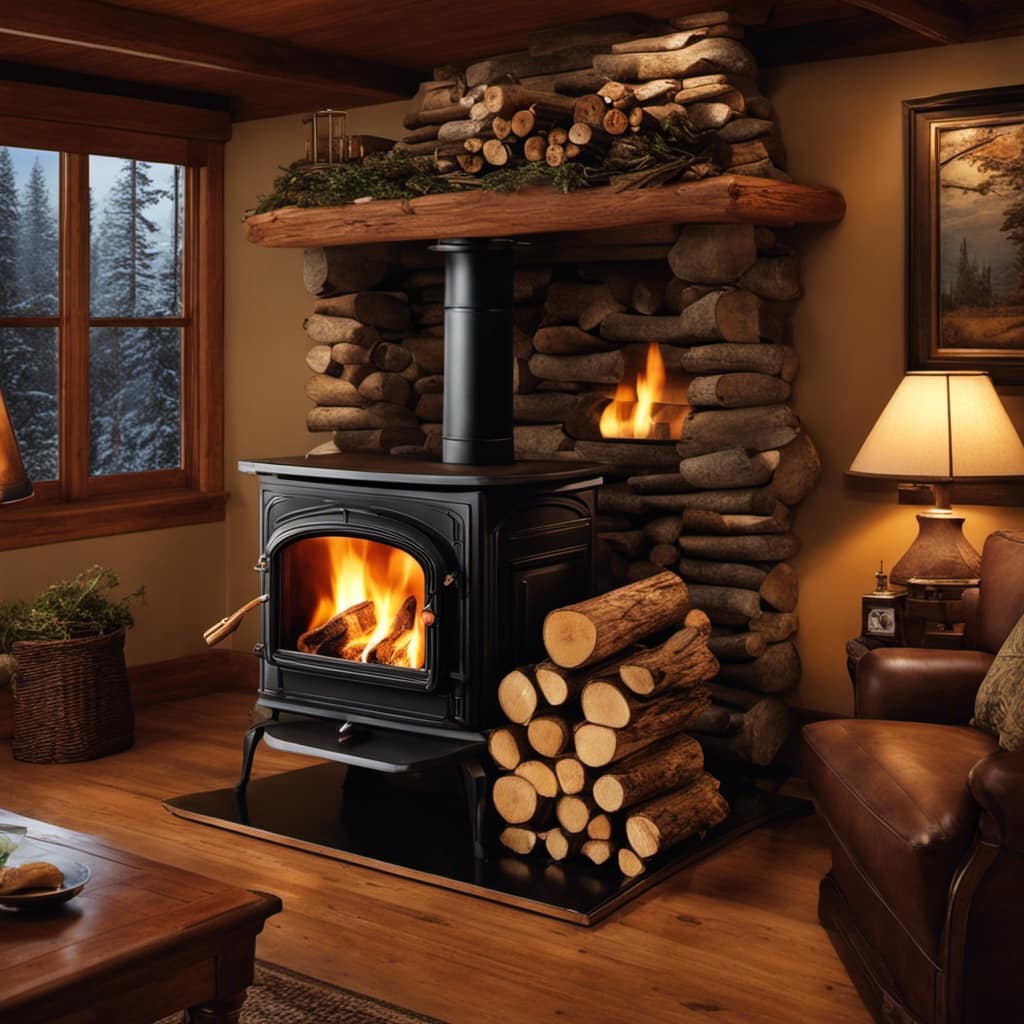
-
Increased safety: A heat shield creates a barrier between the stove and the surrounding walls, reducing the risk of fire hazards. It prevents the walls from getting too hot and minimizes the chance of accidental fires.
-
Enhanced heat distribution: By reflecting the heat back into the room, a heat shield ensures that more warmth is circulated rather than being wasted. This leads to a more comfortable and evenly heated space, allowing me to lower my overall heating costs.
-
Cost-effective options: Heat shields can be made from a variety of materials, including stainless steel, ceramic tiles, or even simple sheet metal. These materials are affordable and readily available, making heat shields a cost-effective solution for improving wood stove efficiency.
Types of Heat Shields for Wood Stoves
One popular option for improving the efficiency of my wood stove is by using a reflective barrier that directs the heat into the room.
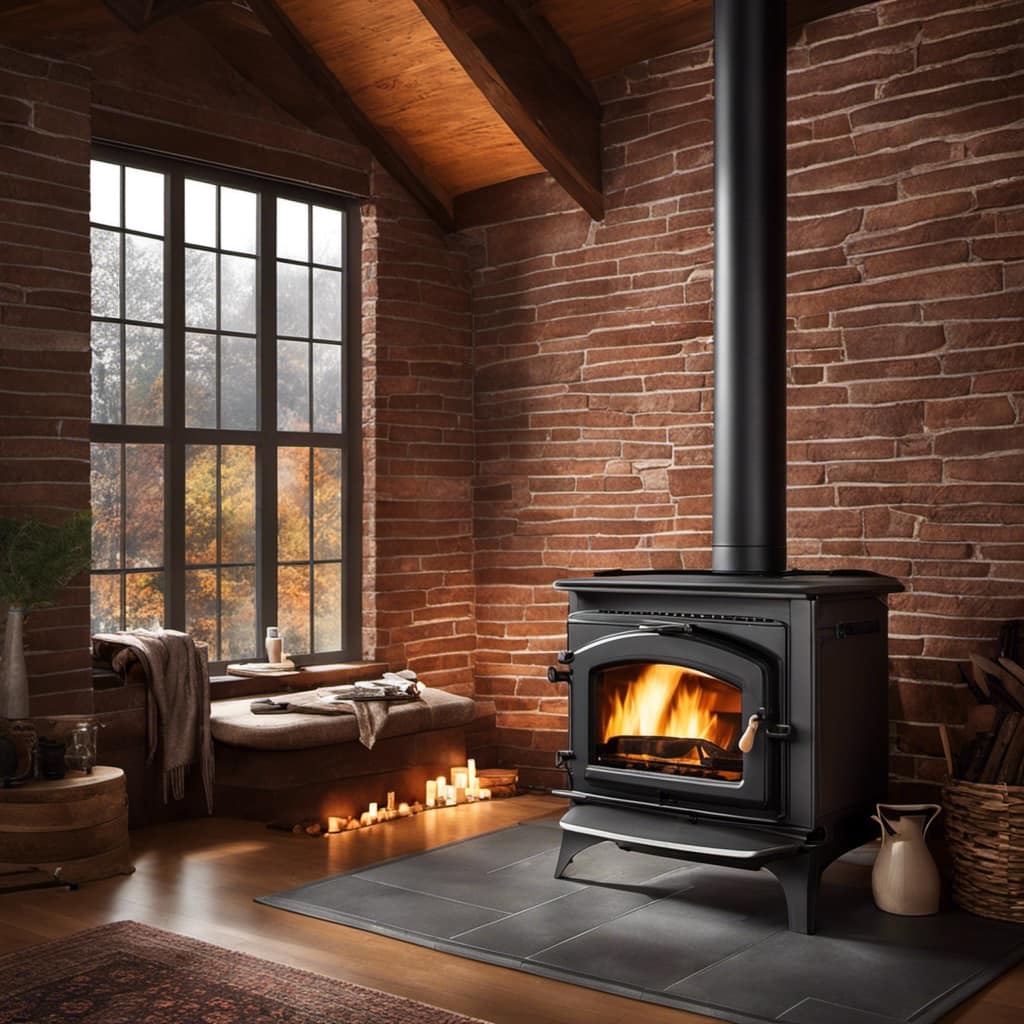
Heat shields are essential components that protect walls, floors, and other combustible materials from excessive heat emitted by the wood stove. These shields come in various materials, each with its own advantages.
One commonly used material is sheet metal, which is affordable and readily available. Another option is ceramic tiles, which are heat resistant and aesthetically pleasing. Additionally, there are specialized heat shield panels made of rock wool or fiberglass, which provide excellent insulation.
The effectiveness of heat shields depends on their design and installation. It’s crucial to ensure that there’s proper airflow between the shield and the wall to allow the heat to circulate and prevent damage. Regular maintenance and inspection are key to ensuring the heat shield remains effective and safe.
Installation Methods for Heat Shields
When installing the reflective barrier for my wood stove, it’s important to ensure proper airflow between the shield and the wall. This allows heat to dissipate and prevents any damage to the wall.
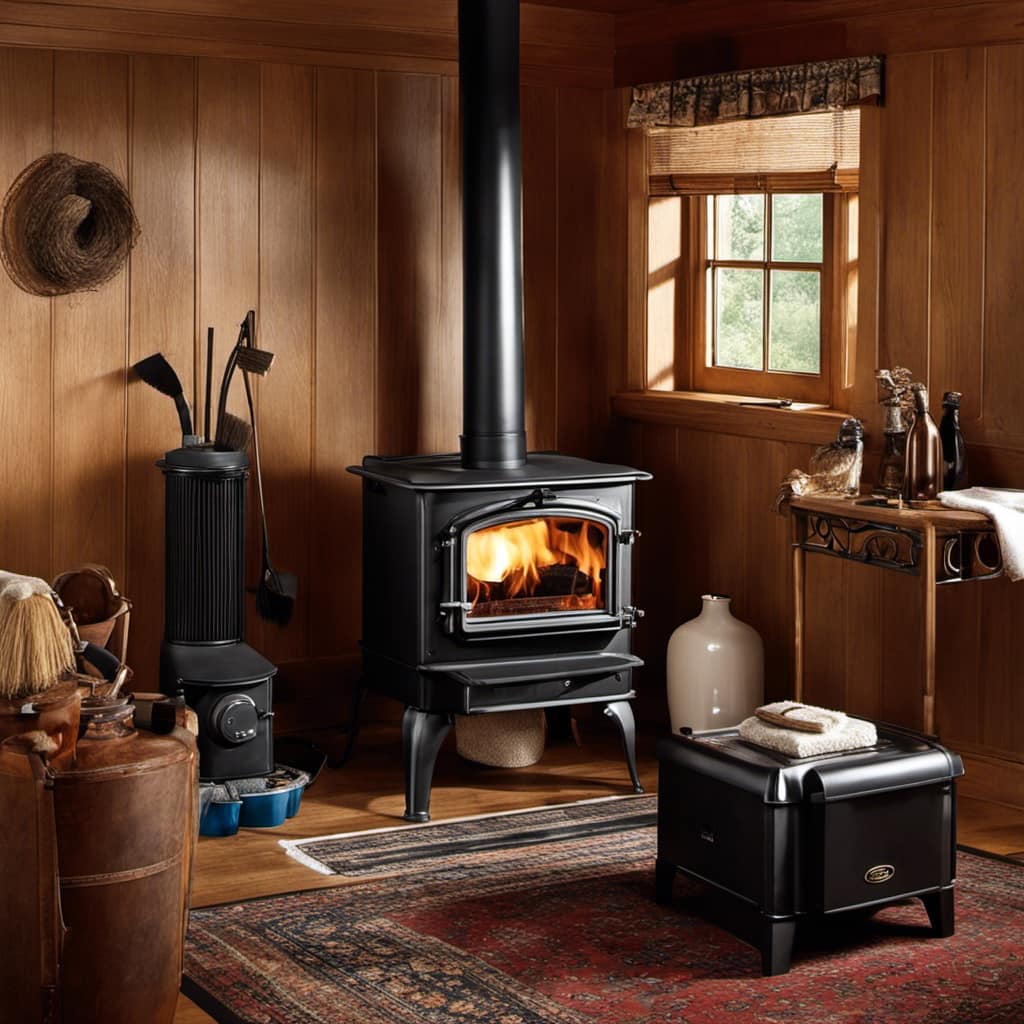
Here are three essential tips for installing a heat shield:
-
Proper spacing for heat shields: The shield should be spaced at least one inch away from the wall to allow for air circulation. This gap allows the heat to escape and prevents the wall from overheating.
-
DIY heat shield projects: If you’re considering a DIY heat shield project, make sure to use non-combustible materials such as sheet metal or ceramic tiles. These materials can withstand high temperatures and provide effective insulation.
-
Secure attachment: Ensure that the heat shield is securely attached to the wall using appropriate fasteners. This will prevent any movement or instability, ensuring the shield remains in place and performs effectively.
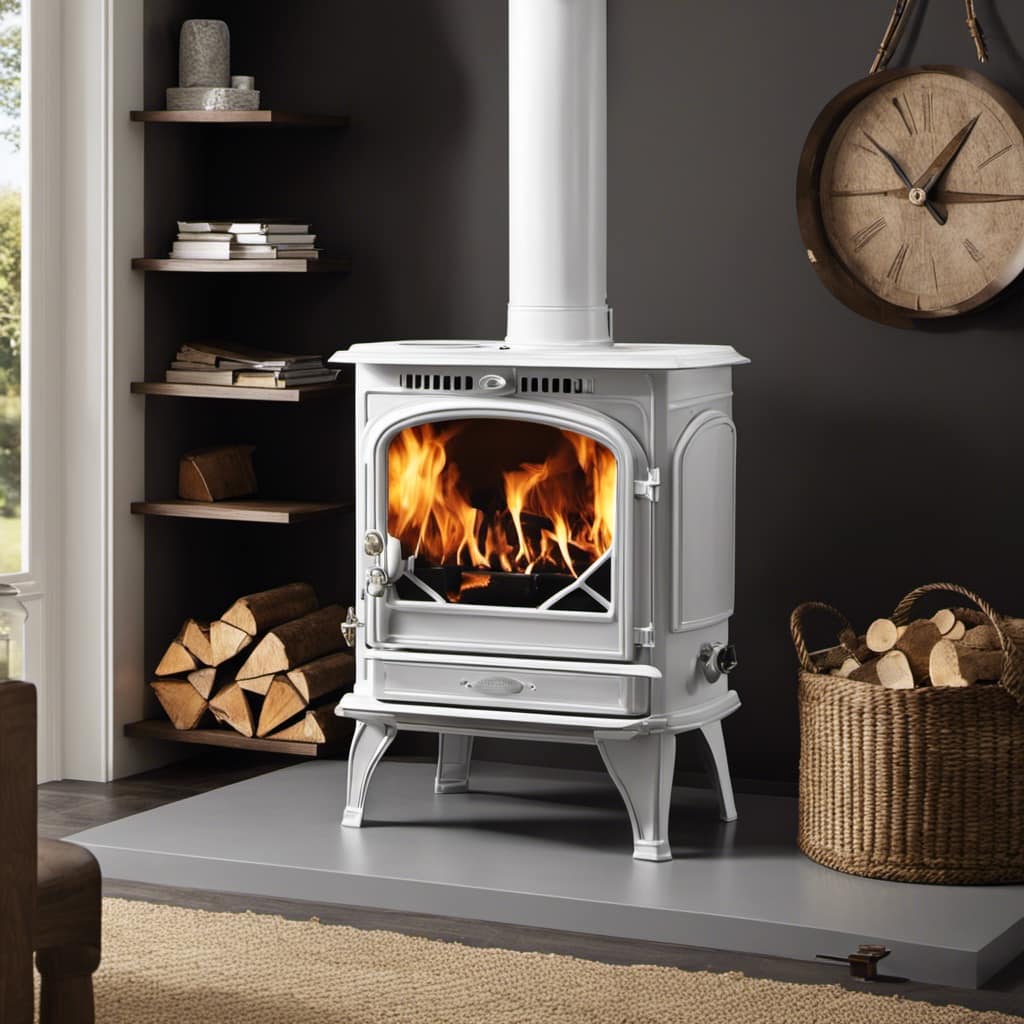
Maintenance and Safety Tips for Heat Shields
To ensure the safety and functionality of my heat shield, I regularly inspect it for any signs of damage or wear. It is important to maintain the heat shield to prevent any potential hazards or accidents. Here are some maintenance tips and safety precautions to follow:
Maintenance Tips:
- Clean the heat shield regularly to remove any soot or debris buildup.
- Check for any cracks, dents, or loose parts and repair or replace them as necessary.
- Ensure that the heat shield is securely attached to the wall or floor.
- Inspect the sealant around the edges of the heat shield and reapply if needed.
- Keep the area around the heat shield clear of flammable materials.
Safety Precautions:
- Always follow the manufacturer’s instructions for installation and maintenance.
- Keep a fire extinguisher nearby in case of emergencies.
- Install carbon monoxide detectors in the room.
- Never leave the wood stove unattended while it is operating.
- Have a professional chimney sweep inspect and clean the chimney regularly.
By following these maintenance tips and safety precautions, you can ensure the longevity and effectiveness of your heat shield while keeping your home safe from potential fire hazards.

| Maintenance Tips | Safety Precautions |
|---|---|
| Clean regularly | Follow instructions |
| Check for damage | Have fire extinguisher |
| Secure attachment | Install CO detectors |
| Inspect sealant | Never leave unattended |
| Clear surroundings | Chimney sweep inspection |
Frequently Asked Questions
Can I Use Any Type of Heat Shield for My Wood Stove?
Yes, you can use any type of heat shield for your wood stove, but it’s important to consider proper installation and maintenance. A heat shield helps protect your walls from excessive heat and ensures safety while enjoying your wood stove.
How Can I Tell if My Heat Shield Is Properly Installed?
To check heat shield installation, ensure proper distance from the wood stove, secure mounting, and follow manufacturer guidelines. Understanding heat shield requirements is essential for safety and to prevent damage to surrounding walls.
Do I Need to Clean My Heat Shield Regularly?
Regular cleaning of my heat shield is essential for optimal performance and safety. By removing built-up soot and debris, I ensure efficient heat transfer and minimize the risk of fire. Plus, a clean heat shield prolongs its lifespan.
Can I Paint My Heat Shield to Match My Room Decor?
Yes, you can paint your heat shield to match your room decor. Before painting, ensure the heat shield is properly installed and follow the manufacturer’s guidelines for heat-resistant paint. This will help maintain the shield’s effectiveness while adding aesthetic appeal.
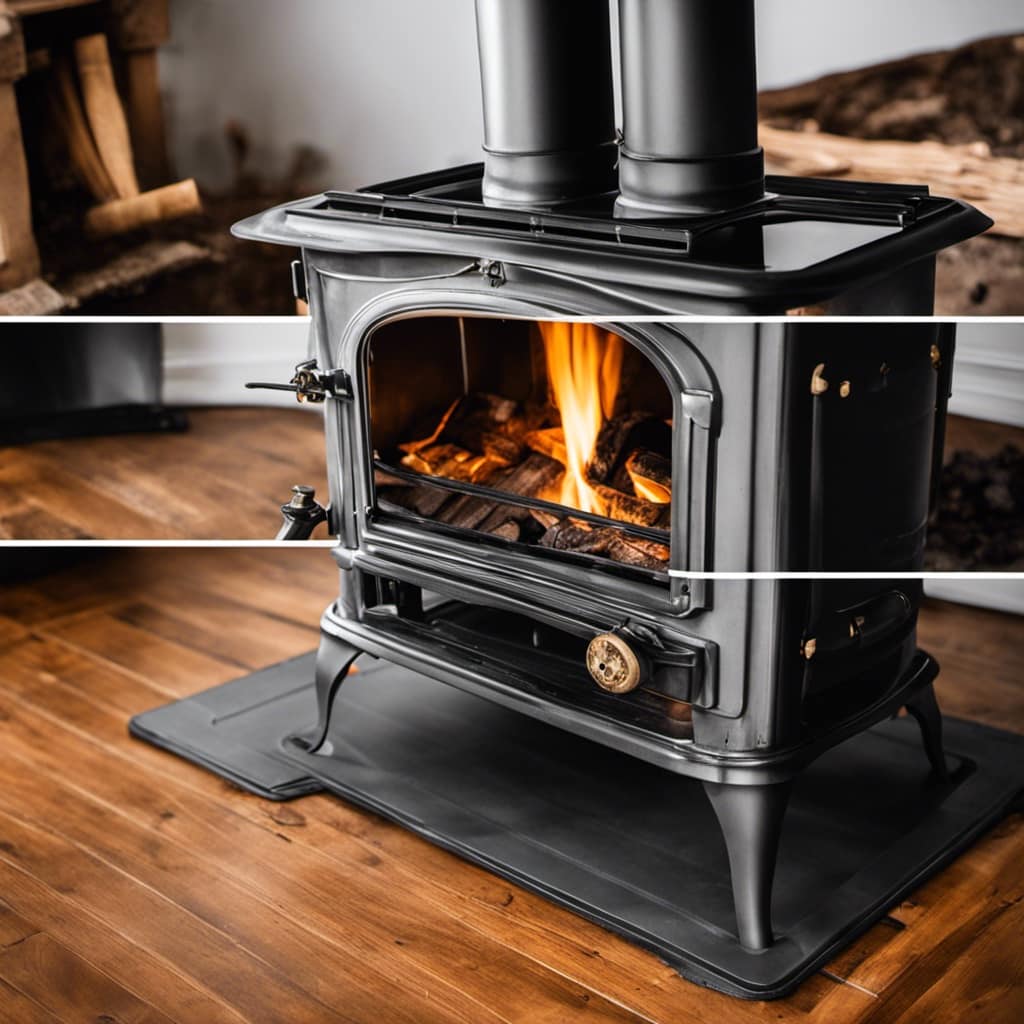
Can I Use a Heat Shield if I Have a Fireplace Insert Instead of a Traditional Wood Stove?
Yes, you can use a heat shield for a fireplace insert. It provides added protection, reduces clearance requirements, and helps distribute heat evenly. A heat shield for a fireplace insert offers numerous benefits and enhances the efficiency of your heating system.
Conclusion
In conclusion, a heat shield for a wood stove is a crucial accessory that provides protection and enhances the efficiency of the stove.
By reflecting heat back into the room, it prevents the surrounding walls from getting damaged or overheating.
The installation of a heat shield is simple and there are various types to choose from, depending on your specific needs.
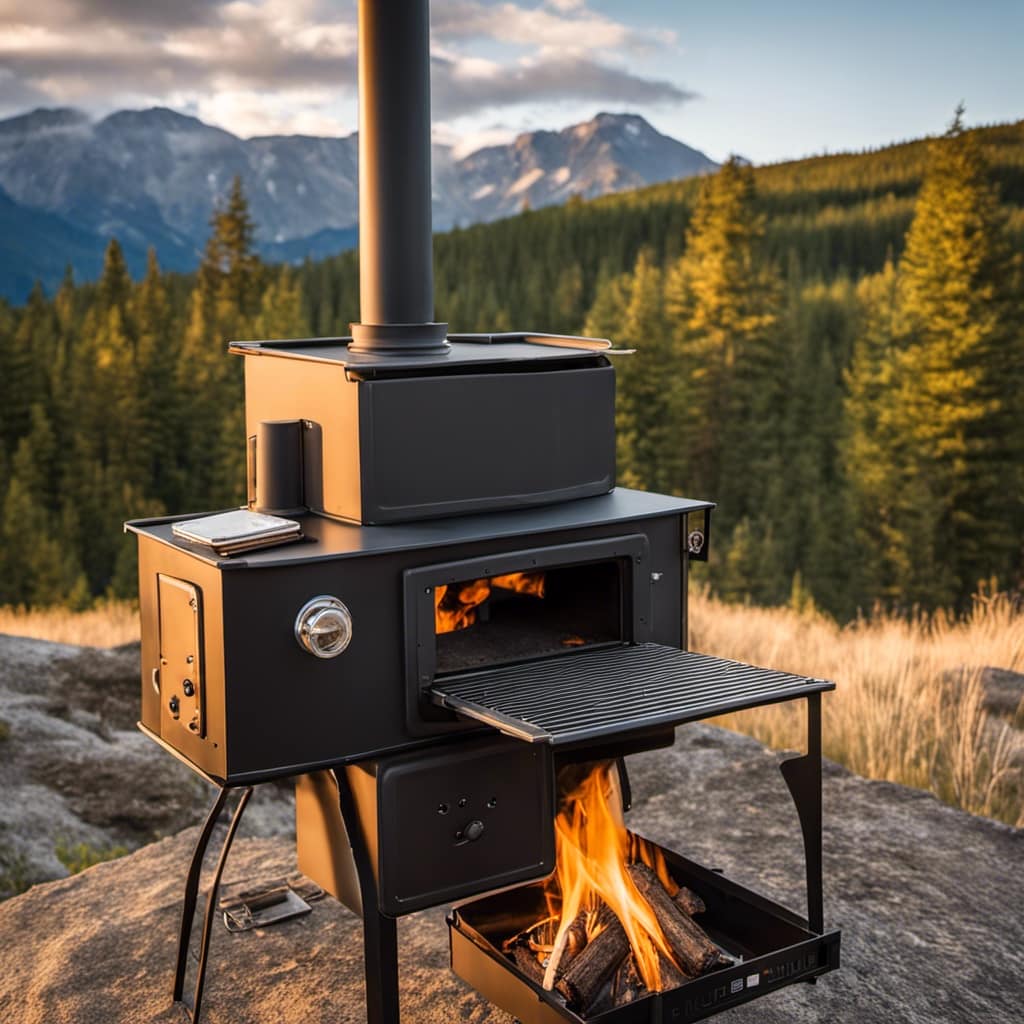
Overall, incorporating a heat shield into your wood stove setup will ensure a safer and more efficient heating experience, creating a cozy and inviting atmosphere in your home.
Growing up surrounded by the vast beauty of nature, Sierra was always drawn to the call of the wild. While others sought the comfort of the familiar, she ventured out, embracing the unpredictable and finding stories in the heartbeat of nature.
At the epicenter of every remarkable venture lies a dynamic team—a fusion of diverse talents, visions, and passions. The essence of Best Small Wood Stoves is crafted and refined by such a trio: Sierra, Logan, and Terra. Their collective expertise has transformed the platform into a leading authority on small wood stoves, radiating warmth and knowledge in equal measure.

